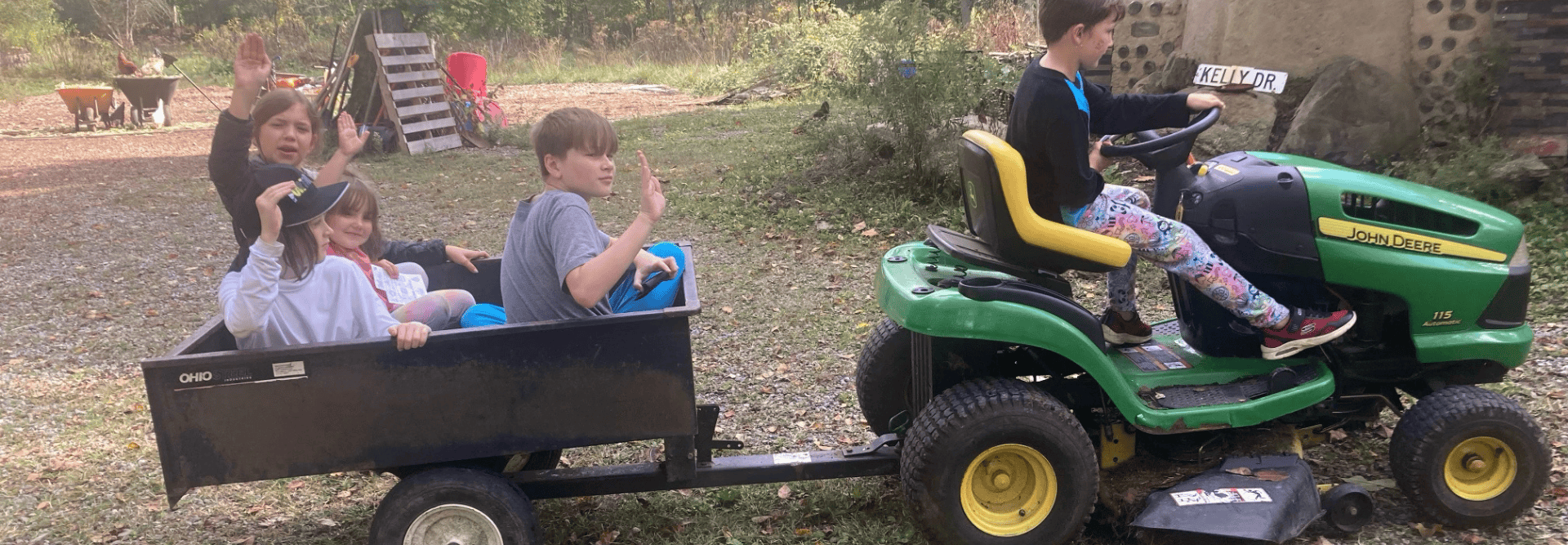In 2012, when Kelly Clark first decided to purchase six acres of land on South Franklin Street, in Bainbridge Township, Ohio, she had recently read The Omnivore’s Dilemma, by Michael Pollan, and decided to see how she might put the concepts of permaculture into practice. “The concept blew my mind,” she says, “because food systems are fundamental to our society and, therefore, everyone participates and influences them.” Subsequently reading Barbara Kingsolver’s Animal, Mineral, Vegetable made her wonder if she could emulate the practices of Kingsolver’s family in only eating food that originated within a 100 mile radius of their home in Virginia. So Clark began to visit local farmers’ markets in order to learn which foods were being offered by local growers.
By the summer of 2013, she and her sister were determined to open a summer camp program on the property. Initially they offered six weeks of camp running from 9:00-3:00 each day and fielded seven or eight campers, on average. They would make farm crafts, learning to finger-knit and needle felt, as well as to make cheese and ice cream, lip balm, salves and more. They also played games as well as spending time hanging out with chickens and feeding the goats and sheep. However, despite her professional expertise as a teacher, it was not long before she noticed resistance from some of the campers to the structured activities. So they started making the planned activities optional and allowing campers more time for free play.
Then she picked up another book, one that radically altered her thinking about children and how they learn. “Reading the book Free to Learn resonated with me immediately, in particular, as it reminded me of my childhood playing with neighborhood kids of mixed ages, with much of that time spent exploring the woods unsupervised by adults. In thinking about it, I realized that although I had always been a good student, the most important and impactful memories and the positively formative experiences I had were outside of school. Yet, I continued, to that day, to have nightmares about being late for school or being unprepared for classes or tests.”
“Perhaps school is not as beneficial as we think, and if my negative feelings about school persisted, what about kids who were not as successful at jumping through the endless hoops that schools force on children? As a teacher I had always questioned the value and fairness of constantly grading students, and reading Peter Gray’s book convinced me that such unasked-for evaluations were, in fact, harmful. I now no longer blamed myself when lessons I had planned so carefully failed to excite my students or for the fact that final exam results were always so disappointing. It was not due to my failures as a teacher, but rather the futility of a coercive system. What a waste of time and effort for so many people! And looking at my students, I could now see the terrible cost that our educational system inflicted in reducing self esteem, mental, and physical health.”
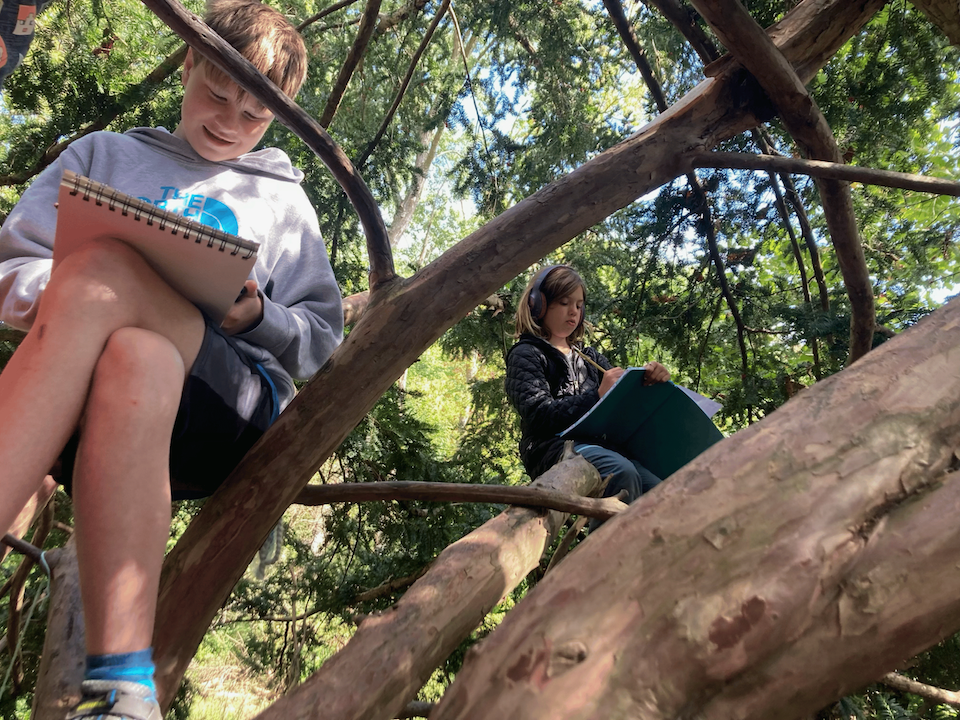
In applying the principles of permaculture to a children’s education program, Kelly uses key concepts such as “systems lens,” “indigenous wisdom,” and “holistic mindset.” In short “Social Permaculture,” simply means to apply those principles to human relationships, communities and social systems. One such principle suggest that participants “operate from patterns to details.” For example, it is a pattern of human nature that children are born with the drive to learn everything they can about the world around them. 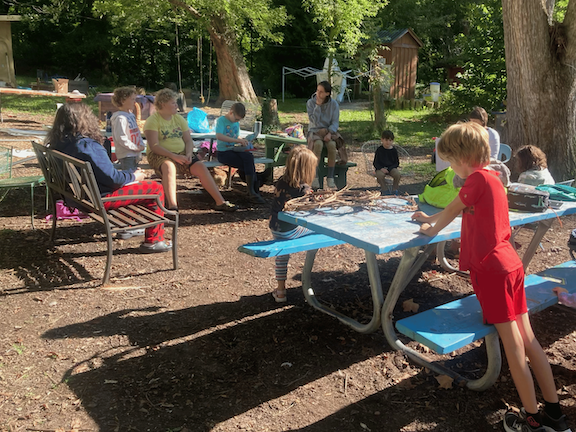
Another guiding principle is to “apply self-regulation and accept feedback.” In the CVLC, participants do so by determining for themselves how to spend their time and learning in the ways that work well for them. In doing so, they take risks and experience the consequences of low stakes failure.
Here is one example: Immediately after a community meeting ends, five of the boys (ages 8-13) plunge into the task of dragging out a heavy bin of Giant Jenga blocks in order to stack them and begin play. Sebastian mainly concerns himself with constructing chair walls around three sides, which players then use as perches for viewing one another’s attempts to remove a block without making the structure tumble. Conversation is robust and grows in pitch and intensity as each boy takes a turn while the tower, consequently, begins to pitch and lean. Rory discovers an end piece that cooperates in its removal and claps his hands over his mouth in disbelief. Sebastian responds by increasing the number of large pillows beneath chairs. Four-year-old Emjay stands on her chair in order to follow each move intently. When two-year-old Willow wanders over, the older boys quickly grab the large container to create a safety barrier for her. When someone does finally knock it over, a loud crash is followed by lots of giggling and excited chatter. Amid all of that, Atticus loudly announces, “Clean-up in aisle 50!” which prompts several of them to join in mopping up a salsa spill before setting up the next game.
Another key component of self-regulation is illustrated in the community governance model of “sociocracy,” as this portrait of a recent community meeting will illustrate. Although it’s mid-February and a few members are absent, Community Meeting begins at its scheduled 11:00 time. Over the winter months, the Chagrin Valley Learning Community has taken up residence in a local church that they share with a program for seniors, daily from 9:00-3:00. Thirteen-year-old Atticus gavels the meeting to order (with a toy stick) and for the first agenda item, calls on Erin, one of the adult staff, who conveys a request from the church to have adult staff accompany youth members in the kitchen when preparing a dish that requires slicing or mixing or things of that nature. She then announces that the seniors are planning to have a St. Patrick’s Day party and asks whether CVLC members would like to collaborate on that event. After a brief discussion, everyone raises their hands in favor of doing so.
Atticus then calls on Paige, the other staff member, who proposes the idea of having a drop-in day for prospective members. Three of the boys express strong enthusiasm for the idea. Paige also favors the idea, but asks that date selection take into account staffing needs on certain days. Atticus says that he likes the idea of recruiting more girls but wonders what will be the procedure if a visitor breaks a rule. Paige points out that it depends on the type of violation because those that affect safety matter the most. Following a discussion about having a nature art day, the meeting ends with a unanimous vote that, “Yes, marshmallows are a fruit!” Apparently this question, which has been heavily debated for the past few days, is now settled.
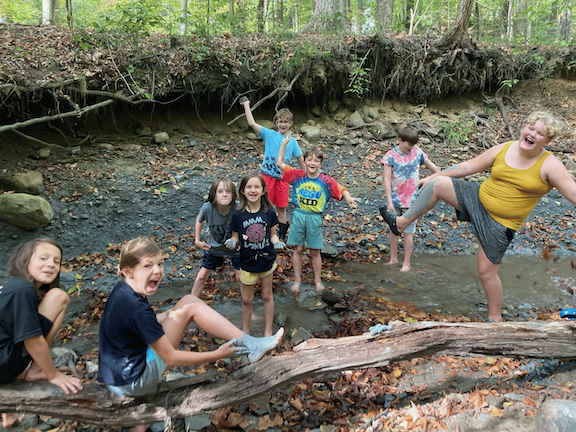
Yet another principle is to “use local/renewable resources and services,” such as libraries, shops, parks, universities, senior centers, local experts, clubs, etc. This one, along with “creatively using and responding to change,” has been essential in keeping their community alive and vibrant for the past few years. In fact, it is only since April, when the weather warmed up, that CVLC was able to return to its home base on Kelly’s Working Well Farm in nearby Bainbridge Township. Unfortunately, they have been unable to occupy their buildings there since the city deemed them in violation of zoning codes in November of 2019. After a few weeks of discussing concerns about fire hazards and school zoning regulations, the township sent notice that the school would have to vacate the premises. Although the farm’s attorney responded that the farm possessed the right to practice agri-tourism, one that had already been approved by the city, with no advance warning, officials showed up and loaded all of the children (and staff) into city ambulances in order to keep them warm and dry until parents arrived to collect their children.
Initially, parents remained supportive of the school and mostly expressed confusion about the township taking away their rights to homeschool their children, within this democratic program on a farm. For the next few months, the community of kids, parents, and staff relied upon the local park district’s lodges until a local church agreed to provide more permanent housing in February. But the advent of COVID closed them down the following month, until September of that year. They were then able to rent space from a local camp, an arrangement that worked until the following March. 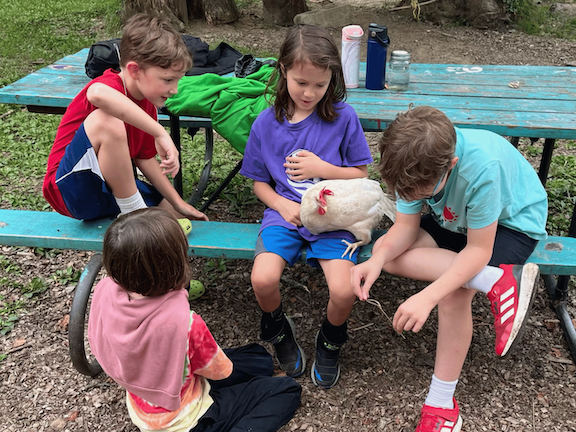
One could easily say that differences in beliefs and values between the township and the CVLC created problems, but it also created opportunities. Staff member Erin Rodriguez celebrates the learning that has transpired because of the need “to adjust and evolve in order to stay open. For example, in renting spaces, we have had to abide by the rules of other organizations.”
Today CVLC and Kelly’s Working Well Farm celebrate the court victory that allows them to practice agri-tourism and continue to facilitate homeschooling on the farm. Currently a small group of staff and youth gather four days a week to care for the farm animals, to build things, to spend time in nature, to learn from one another, to grow their own interests, and so much more. Erin cherishes all of their challenges, “because they not only have made us stronger, but they have also helped us transition to meet the needs of an ever-changing world.”
If you enjoyed this article and feel called to give back to ASDE, here are ways you can support our work:
- Donate money
- Share our content with others! Click one of the buttons above to easily share on Twitter, Facebook, or email.
- Consider becoming a Contributor for Tipping Points
Tipping Points Magazine amplifies the diverse voices within the Self-Directed Education movement. The views expressed in our content belong solely to the author(s). The Alliance for Self-Directed Education disclaims responsibility for any interpretation or application of the information provided. Engage in dialogue by reaching out to the author(s) directly.


